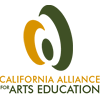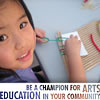Research Reports
Check here for links to recent research about the design, implementation, and impact of the arts in education, careers, and society. Below is a list of research-related web pages, as well as annotated links to key reports. To submit an annotated link for potential inclusion on this page, please send title, annotation, and full URL to: [email protected].
Research Sites (web pages that post new arts education studies)
Annotated Links
Quality, Equity and Access: A Status Report on Arts Education in California Public Schools Grades Pre-K through 12
This 27-page briefing paper reports on the state of visual and performing arts education in California's K-12 schools, with a comprehensive analysis of the status of arts education and the need for stronger policies to support arts instruction for all California students.
Achieving Balance in Districtwide Arts Assessment Systems
The California Alliance for Arts Education and the California County Superintendents Educational Services commissioned this report from SRI International. It examines issues and promising practices in district-wide systems for assessing student performance in standards-based, sequential K-12 education programs.
An Unfinished Canvas. Arts Education in California: Taking Stock of Policies and Priorities
Commissioned by the Hewlett Foundation, this report inventories state and federal policies affecting arts education in California. It assesses whether or not California schools offer sequential, standards-based courses of study in the arts; describes the roles played by districts, counties, and partner organizations in support of sequential, standards-based programs; examines student access to arts instruction, including participation rates, and the duration and intensity of students’ experiences; describes who provides arts instruction to California students, as well as their preparation and ongoing professional development; describes arts education funding, facilities, and materials; and offers recommendations for state policy-makers, school and district leaders, and parents.
Arts Education in Public Elementary and Secondary Schools: 1999-2000
This report provides national data on arts education in public elementary and secondary schools during 1999–2000 on a wide variety of topics related to how the arts were delivered, such as: the availability and characteristics of instructional programs in music, visual arts, dance, and drama/theatre; staffing; space for arts instruction; and funding sources. Topics included: the educational backgrounds (e.g., degrees, certification, years of experience) of music specialists, visual arts specialists, and classroom teachers; participation in professional development activities; teaching load; teaching practices; collaboration and integration of the arts into other areas of the curriculum; and teacher involvement in arts-related activities outside of school.
Arts Education Research Compendium
Published by the California Arts Council in 2001, this compendium is a collection of research on the arts and academic achievement and arts learning and the brain, model partnerships, policy initiatives, and workforce development.
Champions of Change: The Impact of the Arts on Learning
A report that compiles seven major studies providing new evidence of enhanced learning and achievement when students are involved in a variety of arts experiences.
Creativity, Culture, Education, and the Workforce
Skills developed through an education in the arts and humanities can help America’s workforce remain competitive in the global economy, argues the author of this issue paper. These areas of study, for example, can foster the ability to master fast-paced technological advances; understand and work with other cultures; and solve problems through creative thinking. Further, the arts, cultural and intellectual property sectors are among the largest and fastest growing areas in the U.S. economy.
Critical Links: Learning in the Arts and Student Academic and Social Development
The Compendium summarizes and discusses 62 research studies that examine the effects of arts learning on students' social and academic skills.
DataQuest
Searchable database of facts about California Schools and districts.
Improving Arts Education Partnerships
Although arts education enjoys public support and has been shown to help school children in many ways, it has recently become marginalized through budget cuts and redirection of resources to other subjects. One way to supplement arts education is through partnerships between schools and arts organizations. This research found that joint-venture partnerships can yield many benefits but are less common than simple-transaction partnerships in which schools typically select prepared programs without a needs assessment.
National Education Data Web Site
Schoolmatters.com collects and aggregates state data on per-pupil expenditures, standardized test scores and enrollment demographics, teacher compensation and other factors to facilitate comparisons across school districts and between states. The site is administered by Standard Poor's School Evaluation Services, a division of The McGraw-Hill Companies, and gets funding from governmental and institutional sources. Go to www.schoolmatters.com
Involvement in the Arts and Success in Secondary School
This summary of research by Dr. James S. Catterall, UCLA Imagination Project, Graduate School of Education and Information Studies, reveals how involvement in the arts is linked to higher academic performance, increased standardized test scores, more community service, and lower drop-out rates regardless of socio-economic status.
Third Space: When Learning Matters
Third Space tells the riveting story of the profound changes in the lives of kids, teachers, and parents in ten economically disadvantaged communities across the country that place their bets on the arts as a way to create great schools. The schools become caring communities where kids - many of whom face challenges of poverty, the need to learn English, and to surmount learning difficulties - thrive and succeed and where teachers find new joy and satisfaction in teaching.











